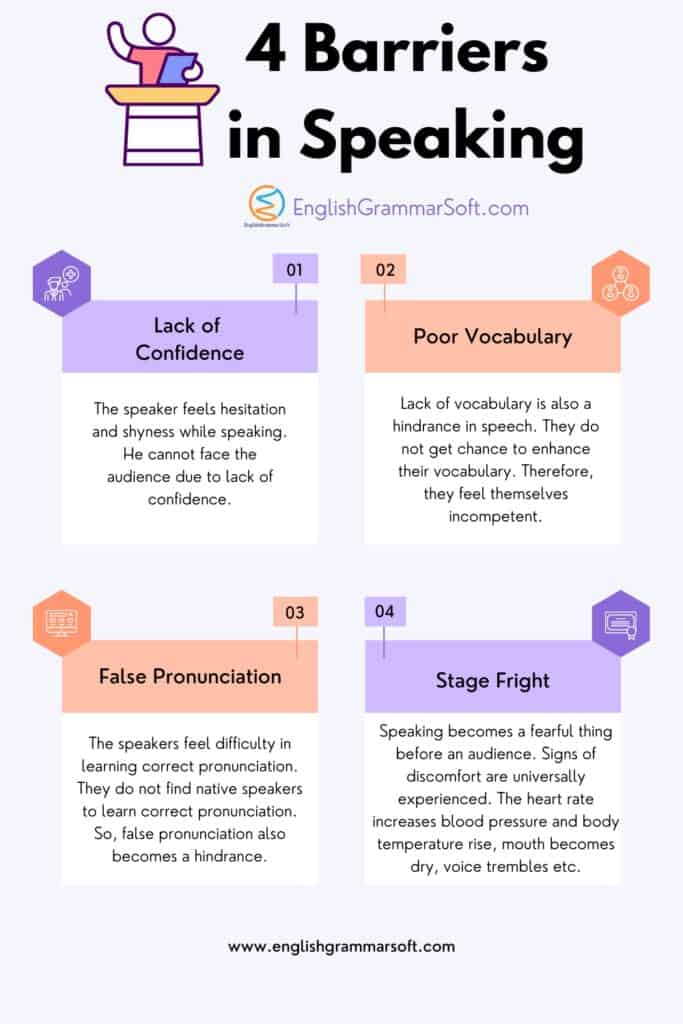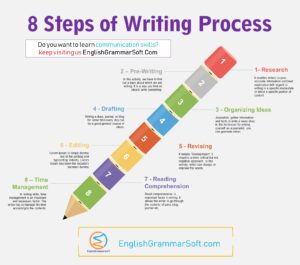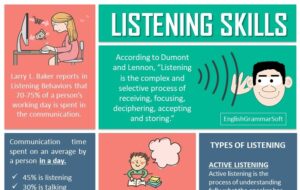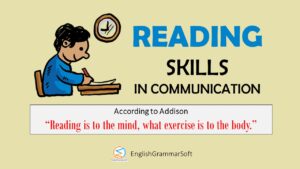Speaking Skills in Communication (Definition, 5 Barriers & 7 Tips for Improvement)
Speaking Skills
Speaking is described as an interactive process of constructing meaning that involves producing and receiving and processing information. Speaking is an important skill and by mastering it, one can communicate.
The focus of speaking skills is not developing the accuracy of pronunciation but adequacy of fluency and communicative effectiveness.
Fries says; that speech is the most important aim in language teaching. According to Don Byrne, “Speaking is the ability to express oneself intelligibly, reasonably, accurately and without hesitation.
In underdeveloped countries, more emphasis is laid on reading and writing whereas listening and speaking are not given the importance they deserve. There are certain factors responsible for the present situation, such as:
- Large size classes
- Poor training of teachers
- System of examination – focused on reading and writing
- Few possibilities of exposure to the target language culture
- Lack of motivation to use English orally
Elementary Steps in Speaking Skills
Imitation and repetition are important elementary steps in developing speaking skills in English. Imitation and repetition are inter-related, and yet they are distinct. Imitation helps students to pronounce and produce the English utterance they hear from the teacher as closely as possible to the utterance produced by her/him. Imitation is not restricted to mere production of the sounds, phrases, and sentences. It includes also the capacity to produce the utterance in the contexts in which the original utterances were produced.
On the other hand, repetition refers to the acts of producing the utterances in as close a manner as possible to the original. Repetition leads to automatic reproduction of the utterance, and, in the process, some sort of memorization of the sound or structure practiced takes place through repetition.
The Skill of Speaking
A good speaker can:
- Produce the particular English speech sounds and sound patterns, both in isolation and in combination;
- Use appropriate words and intonation patterns;
- Use appropriate words and structures to express intended meaning
- Recall words and structures quickly;
- Organize his thoughts and ideas in logical
- Adjust his speech according to his audience, situation and subject matter.
Purpose of Speech
Generally there are three purposes of speech:
- To inform or instruct
- To persuade
- To entertain
To Inform or Instruct
Here the basic goal is to inform and explain a process. Your teacher most often makes a speech to inform. A the end of conversation, the speaker hopes that the listeners have understood the issue, idea or process.
To Persuade
Here the goal is to make listeners willing to accept the proposal or claim. And the speaker hopes that the listeners will do as they ask them to do. Its example is an advertisement.
To Entertain
Sometimes people speak to entertain. On social occasions such as promotion parties, anniversaries, wedding, this form of oral communication is used.
Barriers in Speaking
For speaking effectively one should try to overcome these barriers.
Lack of Confidence
The speaker feels hesitation and shyness while speaking. He cannot face the audience due to lack of confidence.
False Approach to Teaching
In our schools and colleges, much emphasis is given to reading and writing. Listening and speaking are neglected in our education system. In addition to Grammar Translation Method is used to teach English. The students do not get chance to learn spoken English.
Poor Vocabulary
Lack of vocabulary is also a hindrance in speech. The speakers have less educated background. They are surrounded by less exposed people. They do not get chance to enhance their vocabulary. Therefore, they feel themselves incompetent.
False Pronunciation
In under developed countries, English is taught as a second language. The speakers feel difficulty in learning correct pronunciation. They do not find native speakers to learn correct pronunciation. So, false pronunciation also becomes a hindrance.
Stage Fright
Speaking becomes a fearful thing before an audience. Signs of discomfort are universally experienced. The heart rate increases blood pressure and body temperature rise, mouth becomes dry, voice trembles etc.

Tips to Improve Speaking Skills
The following techniques are suggested to improve and master the speaking skills.
Oral Exercises
In the classroom oral exercises are used to develop oral skills. The students should be given sufficient opportunities to express themselves in general conversation. The subject of conversation must be chosen carefully from the real life experiences of the students.
Pair work and Group work
By skillful use of pair work and group work, the teacher can provide the students opportunity to speak together and practice oral skills to develop fluency and accuracy in speech.
Dialogue
One of the most versatile techniques of language is the dialogue. A dialogue is a talk or conversation between two people. In the classroom, the students can do dialogue practice by asking about the likes or dislikes, family members, hobbies etc of their classmates.
Role Play
Enacting pieces of communicative interaction in the classroom is a popular modern language teaching technique. This activity provides the students opportunities to use language directly and purposefully. Thus they shed their fear of addressing the people.
Chain Stories
Chain story exercises should be practiced at the developed level, as they require quick response from the learners. The teacher begins a story by making a statement and the students add to it new sentences turn by turn. For example;
Teacher : There was a boy
Student 1 : He was passing through the forest.
Student 2 : Suddenly he saw a lion
The development of chain story becomes easier if it is based on the knowledge and experiences of the learners.
Information gap Exercise
Information gap is a sort of dialogue. It is more meaningful and communicative. In this exercise, a person has some information that the other does not have. This shows an information gap. To fill this gap, one person asks questions and the other answers the questions.
Presentations
Oral presentations help learners to develop their oral skills. The teacher assigns presentations to the students. One student gives presentation while the others listen to him carefully. After presentation, the listeners discuss the strengths and the weaknesses of the speaker. In this way, they get accustomed to speak in front of the audience.
Activities
Some of the imitation and repetition exercises may be organized in the following manner:
- Present some simple sentence, phrase, or word and ask students to repeat a conversation, say the questions and the answers and have the students repeat.
- The teacher may use pictures, gestures, pantomime, translation, guessing, and drawing on the board to make the students understand the meaning.
Substitution
Substitution of a word, phrase, or sentence by another is an elementary method which helps students to produce new utterances and to develop speaking skill. Students repeat the sentence. “This is a ball”, several times, and then are given some names of subjects such as mat, cat, rat, one after another to substitute in the proper place.
From single word substitution, one may proceed multiple word substitution, one may proceed to multiple word substitution in the same slot, without making grammatical changes in the frame: this is a pencil: this is a long pencil. Substitution drill can be made more complex as students learn more structures and words.
Day-to-day Expression
These expressions include, among others , Good morning. How are you? Fine, Thanks, Hello, How do you do? Good-bye. These are learned as they are, with some explanation as to their meaning. Unlike other utterances, these are not analyzed into their structural components.
The students may be asked to memorize them and practice using them appropriate to occasion: Good morning, good afternoon, good evening, good day, good night, etc. You should model their pronunciation and use in appropriate contexts and give students repeated practice so that they can incorporate these in their exchanges with you and other students in the class.
Simple Question-Answer Dialogues
Simple question-answer dialogues in given context and object is another elementary method to develop speaking skill. There are three types of questions in English.
Yes/no questions. Do you drink tea?
- “Or” questions. Do you prefer tea or coffee?
- WH-questions. What do you usually drink? What is this?
Speaking through Guessing
Guessing is important for listening comprehension. Guessing can be used also to develop speaking skills. Through the process of guessing students are encouraged to see the patterns of usage and to “invent” the correct words and sentences. Students will guess words and sentences that have not yet been taught to them. By guessing students work out the rules of deriving new words for themselves.
Further Reading






